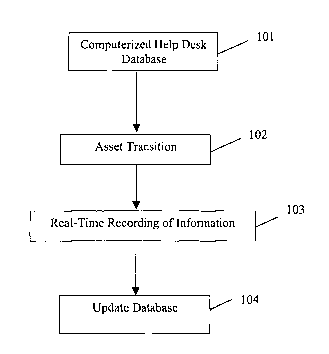Some of the information on this Web page has been provided by external sources. The Government of Canada is not responsible for the accuracy, reliability or currency of the information supplied by external sources. Users wishing to rely upon this information should consult directly with the source of the information. Content provided by external sources is not subject to official languages, privacy and accessibility requirements.
Any discrepancies in the text and image of the Claims and Abstract are due to differing posting times. Text of the Claims and Abstract are posted:
| (12) Patent Application: | (11) CA 2471227 |
|---|---|
| (54) English Title: | METHOD AND SYSTEM FOR IMPROVED HELP DESK RESPONSE |
| (54) French Title: | PROCEDE ET SYSTEME POUR REPONSE DE SERVICE D'ASSISTANCE AMELIOREE |
| Status: | Deemed Abandoned and Beyond the Period of Reinstatement - Pending Response to Notice of Disregarded Communication |
| (51) International Patent Classification (IPC): |
|
|---|---|
| (72) Inventors : |
|
| (73) Owners : |
|
| (71) Applicants : |
|
| (74) Agent: | |
| (74) Associate agent: | |
| (45) Issued: | |
| (86) PCT Filing Date: | 2002-12-18 |
| (87) Open to Public Inspection: | 2003-06-26 |
| Examination requested: | 2004-06-18 |
| Availability of licence: | N/A |
| Dedicated to the Public: | N/A |
| (25) Language of filing: | English |
| Patent Cooperation Treaty (PCT): | Yes |
|---|---|
| (86) PCT Filing Number: | PCT/US2002/040817 |
| (87) International Publication Number: | WO 2003052600 |
| (85) National Entry: | 2004-06-18 |
| (30) Application Priority Data: | ||||||
|---|---|---|---|---|---|---|
|
The method and system of the present invention facilitates an improved help
desk response. Information is first aggregated from a variety of sources into
a computerized help desk database (101). As one or more assets are
transitioned, information relating to each transition is recorded (103) into
the computerized help desk database. Concurrently therewith, the computerized
help desk database is updated (104) so as to improve the speed with which
information is available to the help desk.
La présente invention concerne un procédé et un système permettant d'obtenir une réponse de service d'assistance améliorée. Ce procédé consiste d'abord à recueillir des informations à partir d'une pluralité de sources dans une base de données de service d'assistance informatisée (101), puis, lors d'une transition d'un ou de plusieurs actifs, à enregistrer (103) les informations relatives à chaque transition dans la base de données de service d'assistance informatisée. Concomitamment, la base de données de service d'assistance informatisée est mise à jour (104) en vue d'une augmentation de la vitesse à laquelle les informations sont disponibles pour le service d'assistance.
Note: Claims are shown in the official language in which they were submitted.
Note: Descriptions are shown in the official language in which they were submitted.

2024-08-01:As part of the Next Generation Patents (NGP) transition, the Canadian Patents Database (CPD) now contains a more detailed Event History, which replicates the Event Log of our new back-office solution.
Please note that "Inactive:" events refers to events no longer in use in our new back-office solution.
For a clearer understanding of the status of the application/patent presented on this page, the site Disclaimer , as well as the definitions for Patent , Event History , Maintenance Fee and Payment History should be consulted.
| Description | Date |
|---|---|
| Inactive: IPC expired | 2023-01-01 |
| Revocation of Agent Requirements Determined Compliant | 2021-04-01 |
| Inactive: IPC expired | 2019-01-01 |
| Inactive: IPC assigned | 2016-02-25 |
| Inactive: First IPC assigned | 2016-02-25 |
| Inactive: IPC assigned | 2016-02-25 |
| Inactive: IPC assigned | 2016-02-25 |
| Inactive: IPC expired | 2012-01-01 |
| Inactive: IPC expired | 2012-01-01 |
| Inactive: IPC removed | 2011-12-31 |
| Inactive: IPC removed | 2011-12-31 |
| Inactive: IPC deactivated | 2011-07-29 |
| Inactive: Office letter | 2007-04-13 |
| Inactive: Single transfer | 2007-02-09 |
| Time Limit for Reversal Expired | 2006-12-18 |
| Application Not Reinstated by Deadline | 2006-12-18 |
| Inactive: First IPC derived | 2006-03-12 |
| Inactive: IPC from MCD | 2006-03-12 |
| Inactive: IPC from MCD | 2006-03-12 |
| Deemed Abandoned - Failure to Respond to Maintenance Fee Notice | 2005-12-19 |
| Inactive: IPC removed | 2005-06-15 |
| Inactive: First IPC assigned | 2005-06-15 |
| Inactive: IPRP received | 2004-09-14 |
| Inactive: Cover page published | 2004-08-30 |
| Inactive: Applicant deleted | 2004-08-26 |
| Letter Sent | 2004-08-26 |
| Inactive: Acknowledgment of national entry - RFE | 2004-08-26 |
| Application Received - PCT | 2004-07-20 |
| National Entry Requirements Determined Compliant | 2004-06-18 |
| Request for Examination Requirements Determined Compliant | 2004-06-18 |
| All Requirements for Examination Determined Compliant | 2004-06-18 |
| National Entry Requirements Determined Compliant | 2004-06-18 |
| Application Published (Open to Public Inspection) | 2003-06-26 |
| Abandonment Date | Reason | Reinstatement Date |
|---|---|---|
| 2005-12-19 |
The last payment was received on 2004-12-09
Note : If the full payment has not been received on or before the date indicated, a further fee may be required which may be one of the following
Please refer to the CIPO Patent Fees web page to see all current fee amounts.
| Fee Type | Anniversary Year | Due Date | Paid Date |
|---|---|---|---|
| Request for examination - standard | 2004-06-18 | ||
| Basic national fee - standard | 2004-06-18 | ||
| MF (application, 2nd anniv.) - standard | 02 | 2004-12-20 | 2004-12-09 |
Note: Records showing the ownership history in alphabetical order.
| Current Owners on Record |
|---|
| SHAWN THOMAS |
| MICHAEL WOODFIN |
| Past Owners on Record |
|---|
| None |